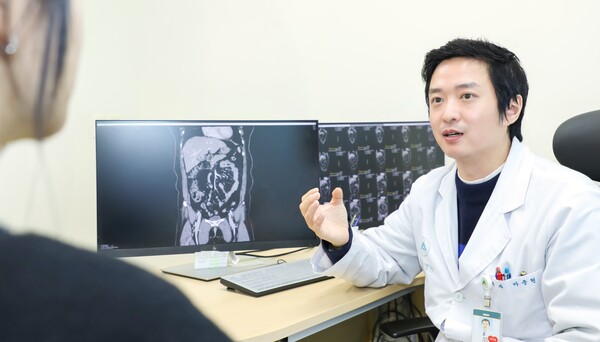A Korean patient, whose identity was withheld for privacy reasons, was recently diagnosed with gallstones in his gallbladder during a medical checkup. The doctor did not recommend gallbladder removal surgery because the gallstones are small and asymptomatic. Still, he is worried that the gallstones could develop into acute cholecystitis or cancer. Should patients with small, asymptomatic gallstones like him remove their gallbladder to prevent complications, including gallbladder cancer?
“There are no major problems in daily life without a gallbladder, but prophylactic removal surgery is not recommended for patients with asymptomatic gallstones,” said Professor Ma Chung-hyeun of the Department of Hepatopancreatic Surgery at GangNeung Asan Hospital on a YouTube channel. “This is because cancer is rarely caused by gallstones alone, and if you maintain a regular lifestyle, you can live without much worry with regular checkups.”

Cholecystectomy is recommended for patients who are at high risk of complications or malignancy, such as large gallstones, multiple gallstones, gallbladder polyps more prominent than 1 centimeter, porcelainized gallbladder (calcification of the gallbladder wall), and a family history of cancer, which are indications for surgery, Professor Ma explained.
Over time, gallstones cause irritation and inflammation within the gallbladder, which damages it. This is a factor that increases the risk of cancer, but it is rare and leads to complications such as chronic cholecystitis, gallstone pancreatitis, or cholangitis.
“Having gallstones does not necessarily turn into cancer,” Ma said. “Cancer is more likely to occur in patients with long-term gallstones, those with accompanying polyps, and those with conditions such as porcelain gallbladder.”
Obesity, rapid weight loss, and high-fat diets increase likelihood of gallstones
Recently, the number of people with gallstones in Korea has been on the rise. According to the Health Insurance Review and Assessment Service, the number of patients who visited hospitals with gallstones increased by about 26 percent, from 152,052 in 2019 to 191,363 in 2023.
Why do gallstones form in the gallbladder, which is responsible for temporarily storing bile produced by the liver before it is used for digestion in the intestines?

Bile contains a proper balance of cholesterol, bile lobes, and bilirubin. When this balance is disturbed, the bile crystallizes and becomes a hard, stone-like mass in the gallbladder.
Factors like obesity, rapid weight loss, high-fat diets, and heredity are known to increase the likelihood of gallstones forming. Certain diseases, including liver disease and diabetes, also play a role. “A healthy diet low in fat and high in fiber can reduce the risk of developing gallstones, but it cannot completely prevent them if you have a genetic predisposition,” Professor Ma said.
Gallstones float freely in the gallbladder and are often asymptomatic. The pain, known as gallstone colic, occurs when a gallstone blocks a passage in the gallbladder or biliary tract, causing pressure to rise.
Intermittent or persistent pain occurs in the upper right abdomen, right shoulder, gullet area, and back when a person normally eats fatty foods. Other symptoms include nausea, vomiting, bloating, indigestion, or feeling overly full.
“Cholelithiasis is the most common cause of cholecystectomy because once the symptoms occur, they often become less frequent and more severe,” Ma said.
Attempts are also made to dissolve gallstones with medications
Gallstones often recur, so a treatment that removes only the gallstones while leaving the gallbladder is not recommended and does not exist. Surgery to remove the gallbladder is the final treatment to prevent future complications.
For people who are at high risk for surgery or who have certain types of gallstones, medications are sometimes used to dissolve these stones.
“In the case of drug treatment, only cholesterol stones are dissolved with drugs such as ursodeoxycholic acid, but the process takes several months, and less than 30 percent of stones are resolved with drugs,” Professor Ma said. “The duration and effectiveness of the treatment should be judged, and the risk of surgery should be weighed to determine the direction of treatment.”
Gallbladder removal can be performed laparoscopically, open, or robotically. Laparoscopic surgery is minimally invasive (meaning it leaves minimal scarring) and uses a camera and laparoscopic instruments through three to four small 0.5- to 1.2-cm holes.
Open surgery involves a large incision in the abdomen, about 15 to 20 cm below the ribs. It is performed when there are severe adhesions or perforations in the abdominal cavity due to previous surgery.
Robotic surgery is similar to laparoscopic surgery in that it is performed using a camera without making a large incision in the abdomen, but it has the advantage of significantly improved vision and clarity and higher precision, which makes it safer. Robotic gallbladder removal surgery is usually performed through a single incision in the navel, which allows for faster recovery and minimal scarring.
Pain varies depending on the procedure, but patients don’t have any problems walking or eating, and they can start walking around and drinking water in the afternoon of the surgery.
After gallbladder removal, patients will no longer have a gallbladder, which is a sac that stores bile. The bile produced by the liver will flow directly into the small intestine through the bile ducts.
Initially, patients may experience symptoms such as digestive distress and diarrhea when eating fatty foods. This may require short-term dietary adjustments, such as avoiding excessively fatty meals, but it usually resolves within two weeks and has little impact on daily life.
“Gallstones are a common problem, but they can be effectively managed with proper diagnosis and timely treatment,” Professor Ma said, recommending that patients see a hepatologist, as the treatment and management options will depend on their condition.

